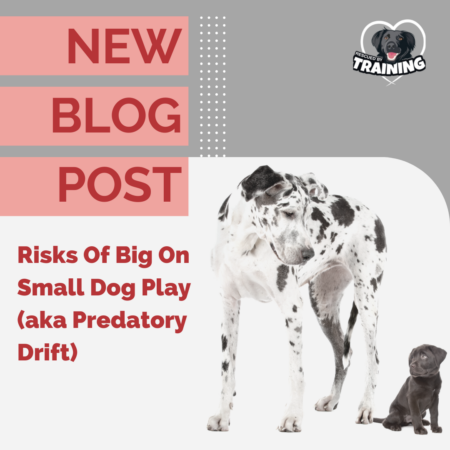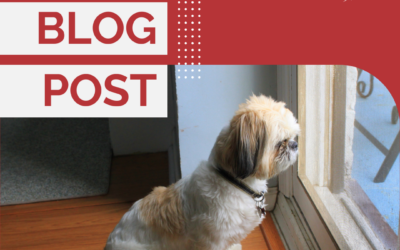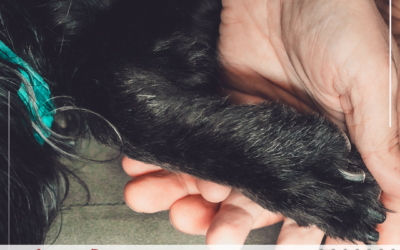Full disclosure, I have a strong bias against big dogs playing with and living with small dogs. There, I said it. Sure, many big and small dogs successfully do play or live together, but for me, the risk of something going wrong, just isn’t worth it. Many may disagree and that’s fine but I want clients to make informed, educated decisions and then assess their risk threshold. That’s my point for this post.
Predatory drift is a term that floats around trainer circles. To my knowledge this concept hasn’t been studied, researched or peer reviewed so it’s a term that trainers use to describe a phenomenon that many of us have witnessed played out. And while the term “predatory drift” may not be scientifically recognized yet, and is generally anecdotal at this point, it doesn’t mean the phenomenon doesn’t happen. Personally, I’ve had clients come to me after a fatality and I know vets who have had to deal with these cases, sometimes even their own dogs. And many, many other trainers have witnessed or have their own client experiences. Chances are if you’re a dog park regular, you may have also experienced it. So for the sake of terminology and simplicity I’m going to describe what is meant by most when using the term.
Predatory drift, a term identified by renowned behaviorist and veterinarian Dr. Ian Dunbar (based on the original term “instinctive drift” from Breland & Breland in 1961), describes a predatory sequence that typically gets triggered by a normal social interaction (commonly play) between two dogs, often a large and small dog. The trigger most often is the smaller dog squealing or yelping, similar to what a small prey item would do when threatened, which seems to “flip a switch” in the bigger dog’s brain that this dog, a previous playmate, is now perceived as prey, not playmate, and the predatory sequence is initiated, culminating with a final, often fatal, grab and shake.
Predatory behavior should not be confused with “normal” aggression, though it commonly is lumped into dog-dog aggression.
This is an important distinction. What predatory drift/predatory behavior is not:
- Predatory drift is not the same as “normal”, predictable dog-dog aggression.
- Dog-dog aggression due to poor socialization isn’t predatory drift.
- Play skill deficit isn’t the same as predatory drift.
- Fear aggression isn’t the same as predatory drift.
- Social Maturity changes are not the same as predatory drift. (Read my post on Sociability and Social Maturity here.)
- Normal dog sociability preferences are not the same as predatory drift.
- Dog-dog bullying is not that same as predatory drift.
Despite being domesticated over 12,000 years ago, dogs remain hunters instinctively. You witness holdover behaviors observed in dogs from their past – walking in circles before lying down, caching bones, marking territory or guarding valuables or food, even though these behaviors are unnecessary in their current domesticated lifestyle.
We’ve done a generally good job at honing through selective breeding to have herding breeds that will herd livestock by stalking, chasing and mouthing them, but not hurt the livestock. We have selectively bred hunting and retrieving dogs to have incredibly gentle, “soft” mouths so they do not damage the hunter’s prize.
But, when dogs hunt, they follow a standard predatory sequence to be successful: search/orient, eye, stalk, chase, grab/bite, shake/kill, dissect, consume. Most (good) selective breeding has bred out or reduced the last few steps of this sequence, although you might see remnants of it pop out with plushy toys when your dog does a grab and shake or pulls the stuffing out.
How to Prevent Predatory Drift
Prevention is key and the only guarantee predatory drift won’t happen. There are no specific risk factors, breeds or other indicators if a dog will or won’t be prone to predatory drift. Any interaction where you can envision a bigger dog being able to pick up the smaller dog in their mouth is potentially unsafe. This may account for why most dog day care facilities split up their attendees based on size and why dog parks have small dog areas.
6 Ways For Safer (but never guaranteed) Big-On-Small Play
- Recognize any dog has the possibility of displaying predatory behavior, even with a prior “good” play history or solid socialization history.
- Big on small play must be very closely supervised and interrupted frequently.
- Dogs who are known “finishers,” meaning they’ve successfully caught and killed small critters (birds, cats, rabbits, rats, squirrels, chipmunks) should not be allowed play with smaller dogs.
- Activity shifts in normal play are essential. Interrupt or stop play if there is a single activity, like chase, without other activities mixed in.
- Immediately stop play if a small dog is simulating prey (quickly running away, especially accompanied with squealing, yapping or high-pitched barking).
- Immediately stop play if several dogs are bullying or ganging up on a single dog. It just takes one dog to accidentally frighten, step on, bite a little too hard or otherwise hurt or startle the small dog to make it squeal or yelp to start the sequence and predatory drift may take over.
Even if predatory drift isn’t super common, the risks are high. Fatalities aside, small dogs can be frightened during big on small interactions and that risk must also be considered when weighing whether that social interaction is worth having. Remember, part of dog guardianship is being responsible for what happens to your dog. Is the social interaction and what might be gained worth the risk off a fearful interaction or worse?
It’s also important that predatory drift, like many other behaviors, isn’t a slippery slope. If your dog is prone to predatory behavior with smaller animals, this in no way predicts their behavior with other things like resource guarding, other dog-dog interactions of appropriate size or dog-human aggression.
If you need help with your fearful or anxious dog, schedule your one on one session here! And be sure to sign up for my free weekly newsletter so you don’t miss out on free tips, videos, personal stories, client successes and more!
Happy training!
![]()




